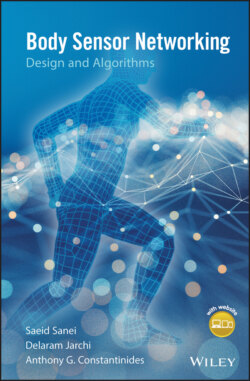Читать книгу Body Sensor Networking, Design and Algorithms - Saeid Sanei - Страница 26
3.2.1.1 How Accelerometers Operate
ОглавлениеA capacitive accelerometer measures acceleration by changes in the internal capacitance of the device. These devices are typically fabricated using MEMS technology on microstructures built into polysilicon. Some microstructures are fixed and some are movable, suspended from fixed points. By impressing a voltage between them, a capacitive effect arises from the electronic charge stored in these structures which is proportional to the area and the physical distances between these structures. External physical movements cause the distances between the microstructures to change, which in turn results in changes to the capacitance. These variations eventually cause changes to the voltage.
Acceleration has two main components: the first being the inertial acceleration that is corresponding to the changes in speed, resulting from rotation or translation, or both. The second component consists of gravitational acceleration arising from the microstructures being deflected in proportion to their static orientation to the gravitational field. Removing the confounding effect of this kind of acceleration [23] can be cumbersome.
In the simplified diagram presented in Figure 3.2 the parameter changes corresponding to acceleration happen between a proof mass to which some plates are attached. The proof mass is suspended from the body or frame of the accelerometer device and secured through anchor points. Another set of plates which are fixed to the frame and the changes in the distance between the two induce a change in the voltage between the plates. When the accelerometer frame moves, the inertia of the proof mass induces a reactionary force which is applied to the springs (often fabricated from polysilicon). These springs are affixed to the frame of the device at anchor points. The spring deformation is assumed to be linear so that the accelerometer obeys the familiar mass–spring–damper equation derived from Newton's and Hooke's Laws [24]:
(3.1)
Figure 3.2 Top view of a simplified accelerometer sensor from ADXL50 [49] datasheet. Anchor points move with the device frame, while inertia of the proof mass causes the distance between fixed plates to vary, changing the capacitance [20].
Source: Courtesy of Jarchi, D., Pope, J., Lee, T.K.M., Tamjidi, L., Mirzaei, A. and Sanei, S.
where M is the mass of proof mass, E and D are the distances travelled by the proof mass with respect to the earth and to its anchors respectively, b is the damping factor, and k the spring constant. The differentiation is with respect to time t. In addition, there are electrostatic forces between the fixed and moving plates to be considered. In order to measure the speed of movement, consider the relative motion between the stationary plates and the moving proof mass which changes the capacitance between them.
However, to measure the acceleration, the transfer of charge is amplified electronically by mixing with a high-frequency signal using a double sideband suppressed carrier modulation technique. Finally, the amplitude-modulated signal is synchronously demodulated and amplified.
There are several ways to evaluate the movement resulting from the changes in capacitance. Early methods used closed loop feedback by impressing a voltage on the capacitor plates so the proof mass stays at its original position [25]. Changes in this voltage thus reflect the change in position. More recent methods are open loop, where the capacitance is obtained using switched-capacitor techniques.
Despite the widespread use of accelerometers, there are limitations of current devices which prevent them from being used in even more applications. A prime example is that of deriving the speed and distance moved by performing mathematical integration of the measured acceleration. In practice, the measurements drift and the integration causes accumulation of these errors rendering the readings useless. To overcome this, it is necessary to periodically recalibrate the accelerometer readings. One popular method is zero-velocity update point (ZUPT). Other schemes depend on the instances where an external event indicates an instantaneous null in the movement pattern, for example in between footsteps [25].
Another source of accelerometer disturbance is the noise arising from mechanical sources due to the proof mass being subjected to Brownian motion. Nevertheless, electronic sources themselves generate considerable noise. The conversion of minute capacitance changes to usable voltages requires high electronic gain and, with that, an increase in noise. A widely used method benefits from switched-capacitor techniques, and the oscillation frequency can be superimposed to the main signal, resulting in an aliasing effect. This may be worsened when using chopper amplification with synchronous demodulation, often applied to moderate the effect of drift.
